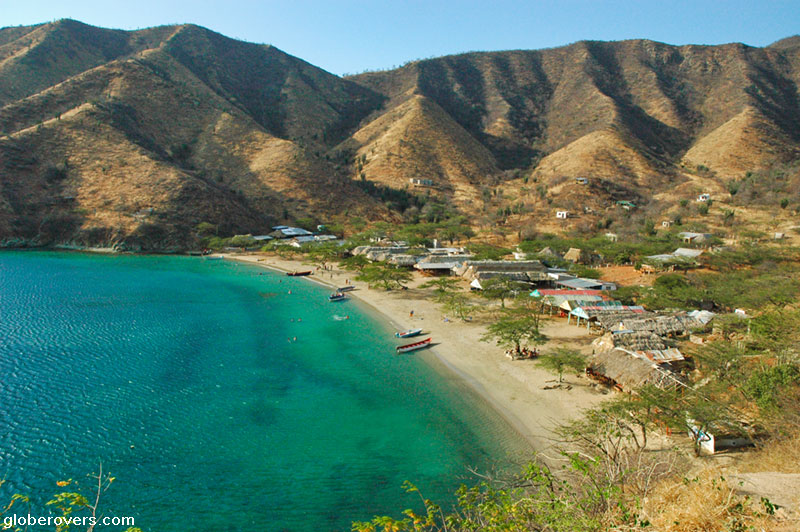
For many years, Colombia has not been a country high on the list of most travellers and holidaymakers. However, times have changed and the country is now open to tourism!
Since 1964, a guerilla movement known as The Revolutionary Armed Forces of Colombia, or Fuerzas Armadas Revolucionarias de Colombia (FARC), has been involved in an armed conflict against the government. FARC wreaked havoc in many parts of Colombia, and while foreigners were not particularly targeted and it has been possible to travel there, many areas were off-limits.
In June 2016 FARC signed a ceasefire accord with the Colombian Government, later rejected in a national referendum. After a revised peace treaty was approved by the Colombian Congress, FARC ceased fighting in June 2017 giving new hope to the tourism industry. Unfortunately, in August 2019 a small faction of FARC leaders returned to armed activity resulting in offensive strikes by the government, killing some FARC members. Nobody knows what the future holds and whether the country is heading back to its days of turmoil. Only time will tell.

While some areas of Colombia are still deemed off-limits except for “all but essential travel”, much of it is safe, despite the usual street crime.
After many years of guerilla fighting, Colombia appears to be safer now. A destination for intrepid travellers ready to be explored.
Over the last few years, adventure seekers have flocked to Colombia before it becomes another hotspot where mass tourism will destroy the charm. Most travellers who visited Colombia safely returned home and have good things to say about it.
Colombia is known for islands such as San Andrés, Providencia and Santa Catalina near Nicaragua, home to some exquisite beaches. Colombia also offers the fascinating Amazonian rain forests, Andean mountains, vast plains of the Orinoquia region along the Orinoco river, and the tropical coasts along the Caribbean Sea and the Pacific Ocean.
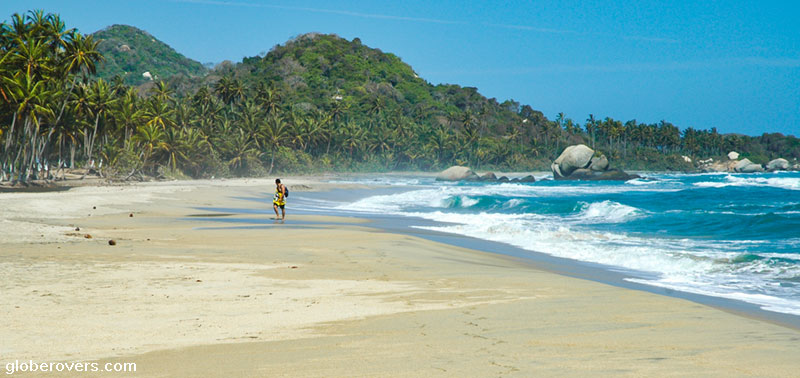
If you are an avid bird watcher, you will be in bird-heaven. With 1870 recorded species, Colombia has the most bird species of any country on earth. The second and third spots are held by Peru and Brazil with 1,817 and 1,767 species respectively. Colombia is home to almost one-fifth of all bird species on earth, though about 160 of its species are at risk of imminent extinction. You may have to compete with the birds to enjoy the wide variety of tropical fruits such as gorgeous guavas, delicious dragon fruit, zingy zapotes, and luscious lulos.
The Colombian north coast along the Caribbean Sea is packed with adventure, still devoid of mass tourism. Float in a bubbling mud volcano, and swim in pristine waters at palm-fringed beaches.
If you prefer city life, Colombia has it. Bogota is booming with funky restaurants, boutique hotels and craft breweries, and since street art was decriminalised in 2011, Bogota’s flyovers, office towers and municipal walls have become canvases for some of the world’s most prolific graffiti artists. Other interesting cities to visit include Medellin, Cali, and Cartagena.
We start our adventure in the northeastern town of Cartagena, one of the most exquisite colonial cities in Latin America. From here we visit a few idyllic islands before heading northeast along the Caribbean Coast to take a gooey bath in an active mud volcano. After a thorough wash in a lagoon, we continue further northeast to Taganga Beach. We end up our Colombia travels in the unspoiled beaches of Parque Nacional Natural Tayrona where we sleep in a hammock between two palm trees.
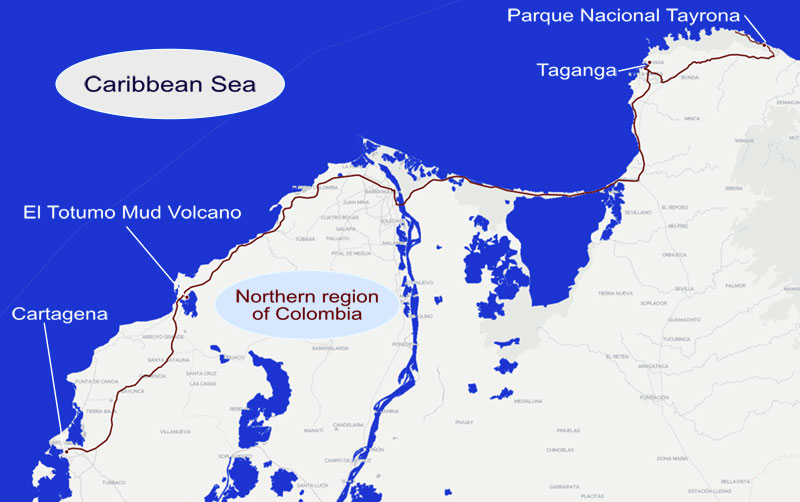
Why travel to Colombia’s Caribbean Coast?
- The low-down: Colombia is one of the top destinations in the Americas! The country has been mostly off-limits for many years and since it opened up to travellers it has so much to be discovered.
- The brightest highlight: The Caribbean Coast of Colombia is a gem to explore – in particular the jungles and beaches of Tayrona National Park (Parque Nacional Tayrona).
- Intrepid destination: While the coast can get quite busy during the holidays, in off-season it is quite deserted.
- Globerovers score (10 is highest): It is a lovely area to discover but be careful of a few bad apples. It gets a score of 8 out of 10.
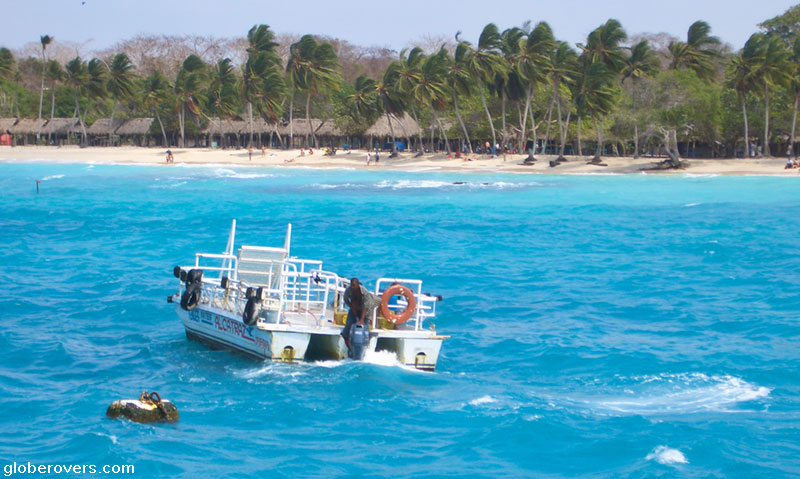
Table of Contents
Cartagena along the Caribbean Sea
Located along the Caribbean Sea in the far northwest of the country, the colonial walled city of Cartagena de Indias was built on gold and slavery and is affectionately known as “Cartagena, the jewel in Colombia’s crown”.
Cartagena is a UNESCO World Heritage Site with a history that dates back to 4,000 BC. In its more recent history, Spanish colonists founded the city in the 16th century and named it after Cartagena in Spain. The city became a centre for Spanish royalty and wealthy viceroys, but endured frequent attacks from invaders. As a protection, high walls were built so the fortressed city now offers some interesting examples of military strategy and well preserved colonial architecture. Cartagena is also much associated with pirates of the Caribbean Sea.

The main city gate, and original entrance to the fortified historical centre is via the beautiful Puerta del Reloj (Clock Gate) leading into the vibrant Plaza de los Coches (Square of the Carriages).
In the colourful old city are several markets, squares, cathedrals, castillo (fortresses) and an increasing number of touristy bars, cafes, boutique hotels and guesthouses.
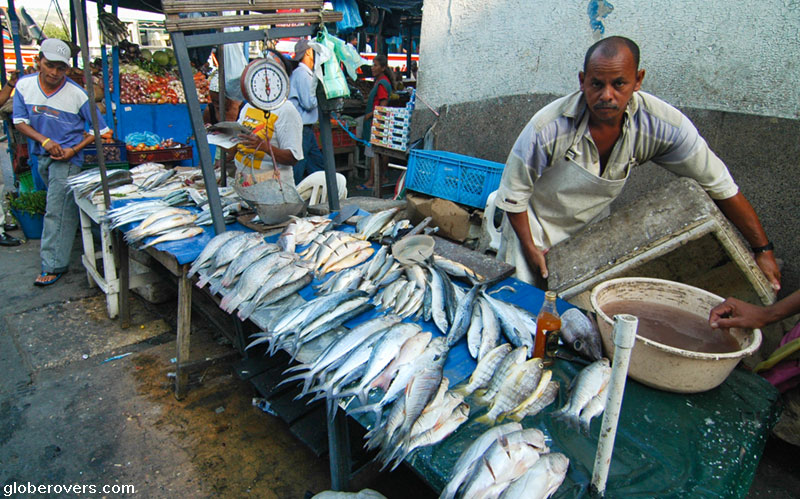
Have a drink in one of the many plazas while watching the horse carts with tourists clattering through the streets. Evenings are often filled with flash mobs dancing in the colourful plazas. You will instinctively start to sway to the rhythm of the traditional musical dances of the cumbia, porro and vallenato.
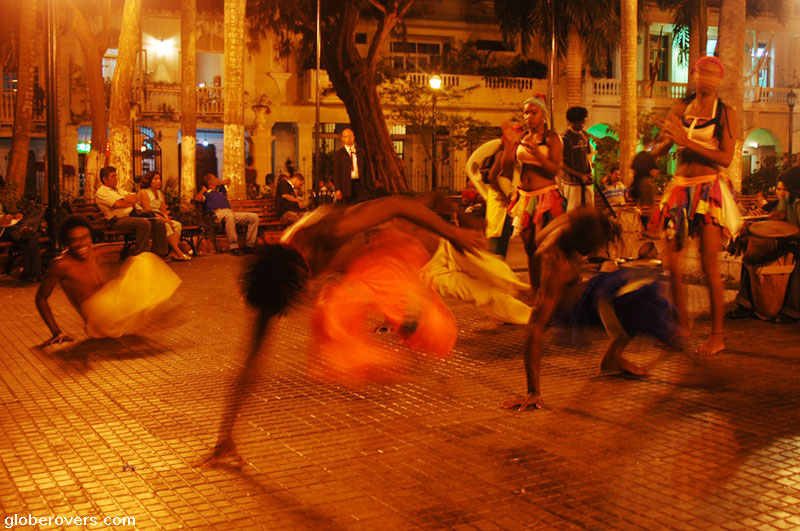
The figurative painter and sculptor from Medellin, Fernando Botero, is famed for his satirical works which feature oversized subjects in an exaggerated form. Don’t miss his bronze woman sculpture, “La Gordita,” who reclines happily in the Plaza Santo Domingo in front of Church of Santa Domingo.
Culture-rich Cartagena is known for its well-preserved colonial architecture.
Immediately outside the old city at a strategic location on the Hill of San Lázaro is Castillo San Felipe de Barajas built by the Spanish during the early 16th century. The best view of Cartagena can be seen from the Convent of La Candelaria, located on top of the La Popa hill which is a short distance east of the old city.
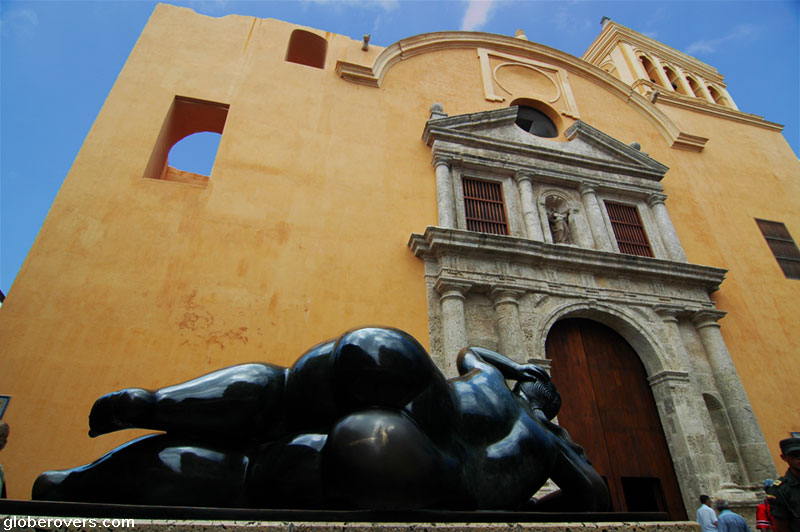
Tired of strolling through the old city and hiking the hills? Then head over to the Bocagrande beaches area, a narrow strip of land with many hotels, shops, restaurants, nightclubs and art galleries.
Take a day-trip to nearby Playa Blanca and Islas del Rosario for incredibly beautiful beaches, islands, birds and marine life. The Rosario Islands also offer excellent diving where divers can admire colourful coral gardens, bountiful marine life, and perhaps a sunken pirate ship.
The Caribbean port city of Cartagena has long been referred to as “the jewel in Colombia’s crown”.
While in Cartagena, take a flight to the Colombian island of San Andrés which lies closer to the east coast of Nicaragua than to the north coast of Colombia. While San Andrés has some exquisite beaches, the prize goes to nearby Providencia island that has over the years retained much of its traditional laid-back charm.

Flights from San Andrés to Providencia are via a small 10-seater plane. Alternatively, take the catamaran ferry which makes the 90 kilometre (56 mi) sea voyage a few times a week.
Cartagena is a one hour and twenty-minute flight north of Bogota. A bus ride to cover the 1,060 kilometres will take about 17 hours and is not recommended due to the potential risk of kidnappers targeting long haul buses.
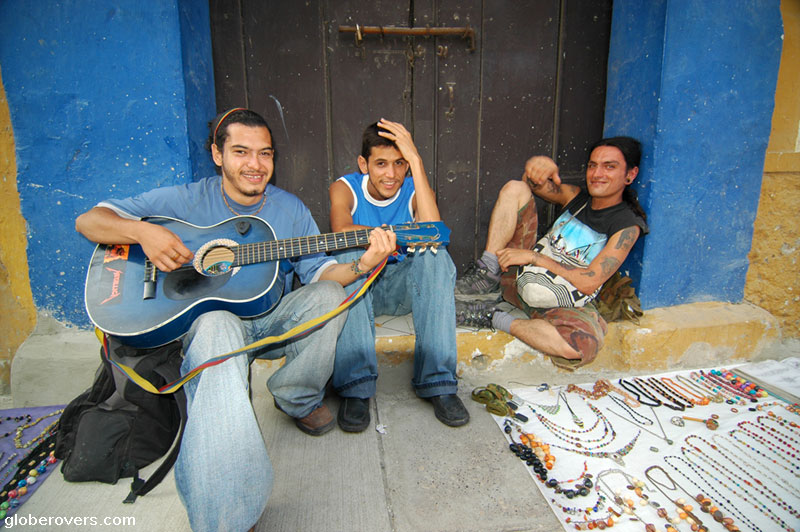
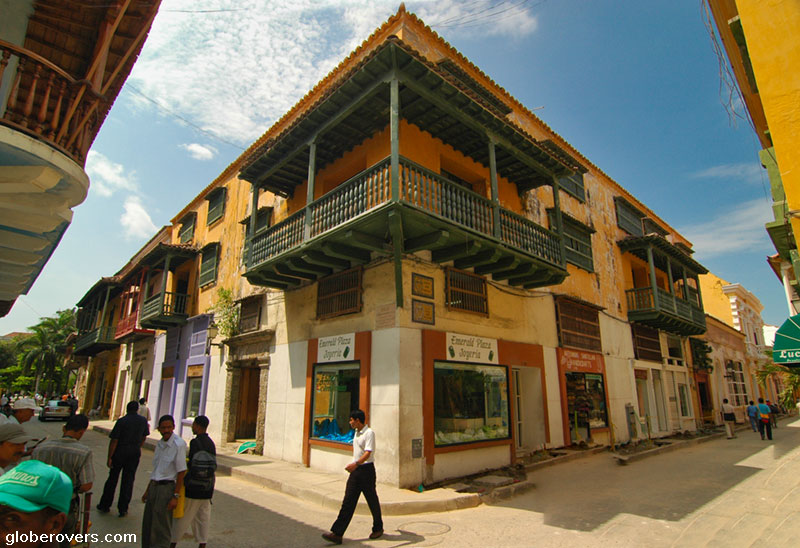
El Totumo Mud Volcano
About 63 kilometres (39 mi) northeast of Cartagena, along the Caribbean Coast, is one of the most bizarre attractions of Colombia, and a rite of passage if you visit Cartagena. El Totumo is the country’s smallest volcano, although it does not spew hot lava or blow smoke. It is an active but peaceful little volcano with a 15 metre (49 foot) mound filled in the core with lukewarm softly bubbling mud. Superfine brown silky mud.
Soak in the soft bubbling mud volcano while getting an uninvited $1 massage.
According to local folklore, Totumo used to spew fire, lava, and ashes, but it was turned into mud by a local priest who believed it was the work of the devil, and endeavoured to banish him by sprinkling holy water into the volcano.

Pay a small fee to the local collector and climb up the rudimentary ladder to the top of the mount. While the mud levels slightly rise and fall over time, it seems that these days its level is more often low than high. Several local entrepreneurs at the bottom of the volcano sell bottles of the volcano’s mud to visiting tourists, which may explain where all the mud is disappearing.
If you are very lucky, you may find the mud near the top of the mount with some spilling over the rim, though most likely you will have to climb several feet down a rickety old wooden ladder that gets extremely slippery to reach the muddy surface. As you look down onto the giggling people drifting on the mud, you may get a vision of catfish flopping around in a muddy watering hole!
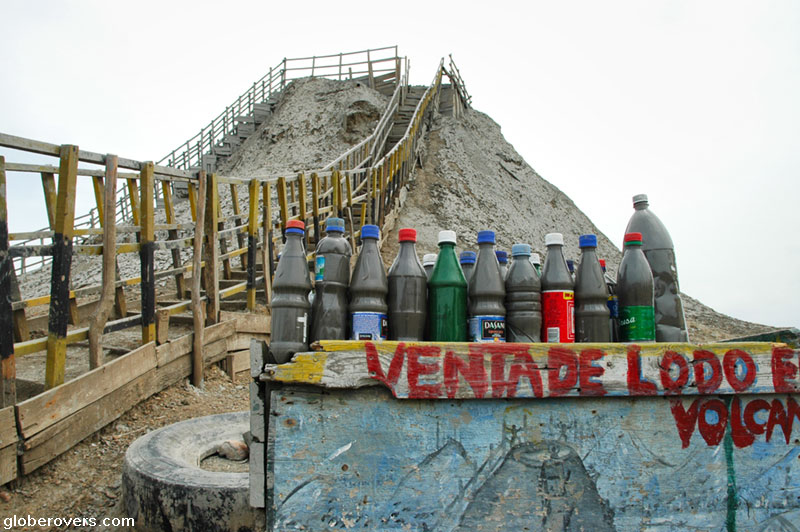
The mud reputedly has healing and therapeutic properties so for many years it has been a popular health-bath for the locals. While few tourists report rejuvenated skin after immersing in the mud, the bizarre experience of floating weightlessly on silky luke-warm mud makes the trip worthwhile.
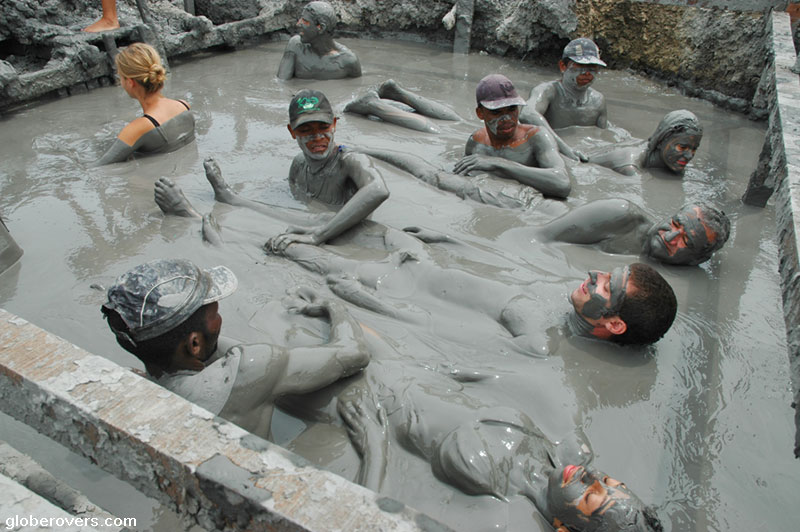
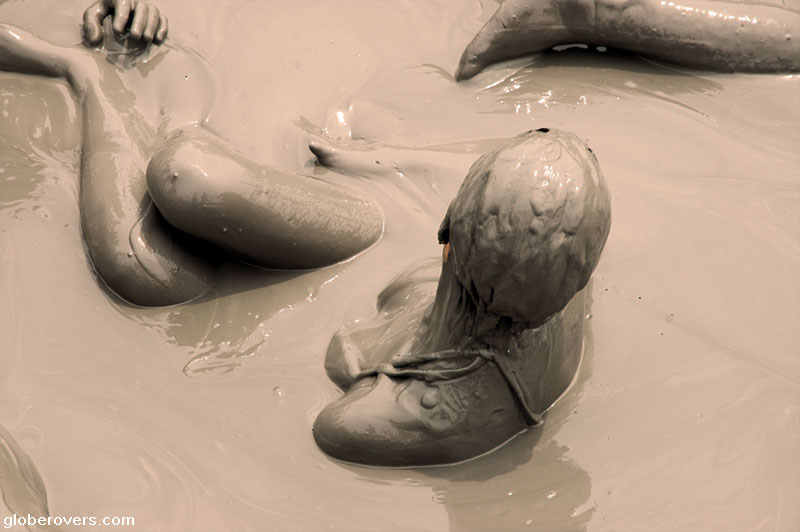
The entrepreneurial local men have realised that tourists are happy to pay a dollar or two for a mud-rub as they lie drifting on the mud. They generally won’t ask permission to render their services, so just take it as it comes and let them mud-rub you. Make sure not to let your face get all muddy as you’ll be sorry if the mud gets into your eyes.
“The local lady pulled off my swimsuit under the water and started to wash my crevices!”
Once you have become a mud-monster, you may leave the pit and pay the lady down below the mount. It is recommended that you let the mud dry before washing. At this time, don’t be surprised if busloads of Colombian tourists come around to take photos of the strange muddy foreigners, probably wondering how people can do this to themselves!
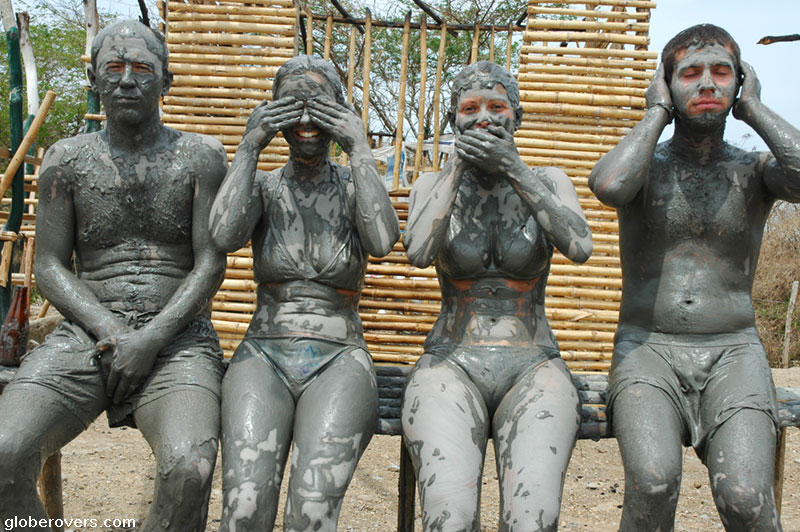
As you stand to dry, several people will have pointed you to the nearby lagoon where you will find a few local ladies wading in the water to wash the tourists. Now, this is another part of the bizarre experience. These ladies also won’t ask permission to wash, so just lay back and let her do her job. She most likely will be digging her fingers in your ears and nose to clear out the mud.
Some ladies will even remove your swimwear to rinse out the mud, scrub your crevices, and put back your swimwear. She is used to doing this so just go with the flow. Once she is convinced that you are clean, slip her a few coins in the hand.
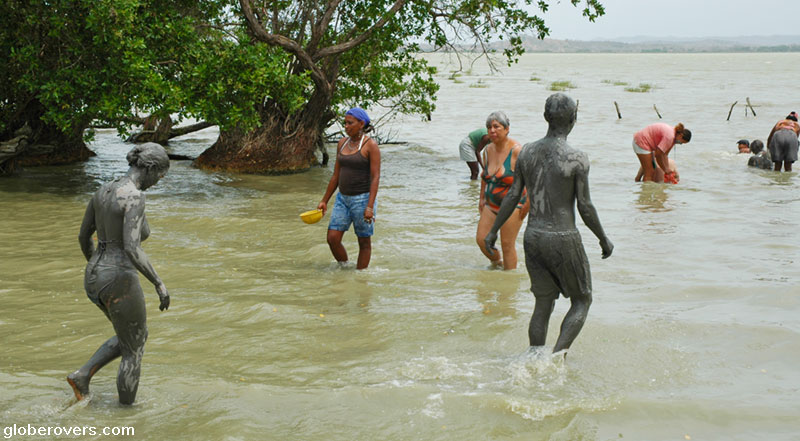
As you sit in the minivan with your clean mud buddies, you certainly will get the sulphuric smell of mud. Don’t despair. Just believe that the healing and therapeutic powers of the mud are hard at work rejuvenating your skin.
Taganga and other Caribbean Beaches
Continue for 67 kilometres (42 mi) northwest along the Caribbean Coast to the city of Barranquilla. While it is an interesting place to linger for a few days, you want to be here during the annual festival. The Barranquilla Carnival is one of the biggest of its kind, giving the likes of Rio a run for its money. Taking place in the middle of summer, the sultry carnival is a big drawcard for tourists who enjoy the streets filled with parades and parties.
From Barranquilla take coastal Route 90, built on a sandy artificial spit, to cross the Ciénaga Grande de Santa Marta marsh to the historic town of Ciénaga. Declared a National Cultural Heritage Site in 1996, you can bathe in Ciénaga’s hot springs and participate in a festival honouring the caimán, a small crocodile. The historical old centre of town is worth a visit, as well as the nearby stilt villages.

From Ciénaga it is a 33 kilometre (20 mi) drive north along the coast to the town of Santa Marta, a prime tourist destination in the Caribbean coastal region. Santa Marta was the first Spanish settlement in Colombia and is now one of the oldest permanent settlements in the Americas. Not surprisingly, it offers great colonial architecture, a whitewashed cathedral, pleasant waterfront, beaches, public market, vibrant street food scene, and endless opportunities to explore nature.
Our next destination along the Caribbean coast is the fishing village of Taganga, just five kilometres (three miles) further up along the coast from Santa Marta. Taganga is a place where beautiful lush green covered mountains meet a horseshoe-shaped bay.
Located close to the port city of Santa Marta, Taganga is sun, sea, and surf.
Truly a beautiful location, which looks even more beautiful once you hike the nearby hills overlooking the sea.
While Taganga was a rustic fishing village for many years, nowadays it has become a haven for backpackers, party animals, and scuba divers. Here you will find no shortage of dive shops, seafood restaurants, hostels, and places for beer parties. While the beach used to be popular for swimming, it is no longer as clean as it used to be.
Take a hike into the hills for stunning views over the ocean and the village, and go swim at nearby Playa Grande to the north of the village. Another lovely beach is Playa Bonito Gordo in nearby Parque Nacional Natural Tayrona which is best reached by boat from Taganga beach or by walking from Bahía Concha inside the park.
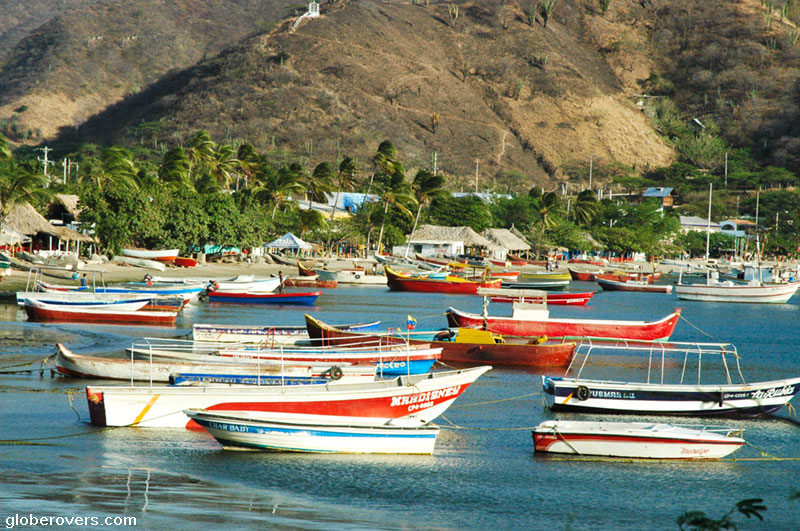
Note that Taganga has a reputation for street crime, so be careful, especially at night.
South of Taganga is La Cuidad Perdida, also known as “Teyuna” and “Buritaca”, an archaeological site in the Sierra Nevada mountain range. This “lost city” is believed to have been founded at the start of the ninth century, which makes it about 750 years older than Machu Picchu in Peru. On the way to Ciudad Perdida, stop at Minca to the southeast of Taganga. Minca is a beautiful tiny town located in the hills and jungle and has become a popular spot among travellers due to its remote location, coffee farms, waterfalls, and excellent hiking trails.
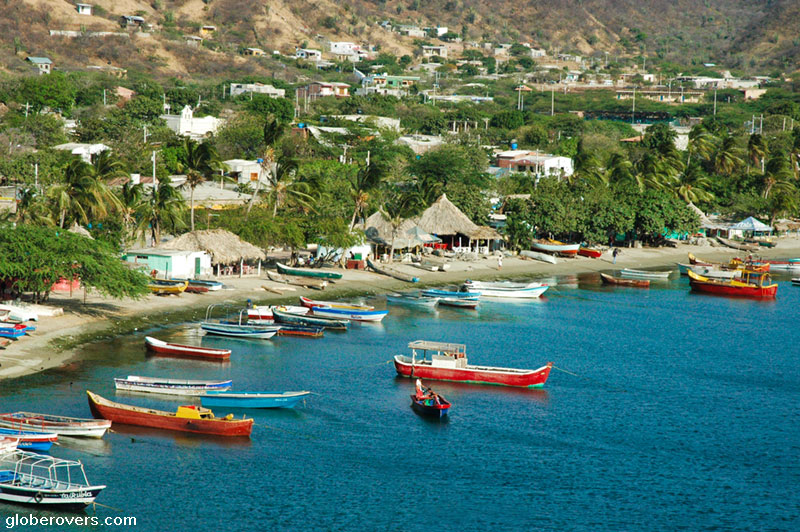
Parque Nacional Tayrona
Just a few kilometres to the northeast from Taganga lies the western edge of Parque Nacional Tayrona which stretches for about 30 kilometres (19 mi) along the Caribbean Coast. The park boasts in excess of 60 mammal species as well as over 400 species of birds, in addition to countless reptiles and amphibians. This is the main reason why we came to northern Colombia and this is why we would not want to leave this incredible country.
As a protected area in Colombia’s northern wilderness, Tayrona National Park has all the elements you want from an idyllic location along the Caribbean Sea. Come here if you like swaying palms trees, beautiful sandy beaches, lagoons, ancient ruins, and most of all, peace and quiet. Still free of major developments, the park has a lot of rugged beauty to offer those who made the effort to reach this part of the South American continent.
From Santa Marta, hop on a bus or taxi to the most eastern part of the park. From the drop-off point at the park entrance, it is a few kilometres walk to the beaches.
A nature sanctuary along the Caribbean Sea, rich in fauna and flora.
Among the best beaches along this part of the park are Arrecifes, the nearest beach to the park’s main entrance, Cabo San Juan de Guia, Cañaveral, and La Piscinita. Most of these beaches offer tents and hammocks for rent, and some basic restaurants. The best option is the hammock! While the open-air hostels have several hammocks lined up in a row under a canopy, the more adventurous way to sleep is to find two palm trees along the beach and spend the night swinging in the breeze.
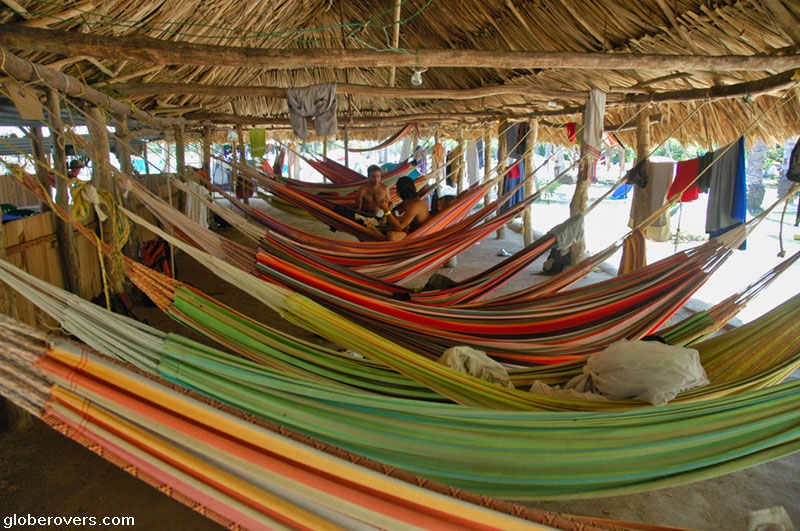
Need a break from the beautiful sandy beaches? Take an invigorating hike into the jungle to ancient ruins where you will pass through several streams and giant boulders. Keep your eyes peeled for the multi-coloured land crabs, leaf cutter ants, bright blue and green reptiles, countless butterflies, and if you are lucky you may see the endangered cotton-top tamarin monkey with its fluffy white mane.
A mere two-hour hike from the Cabo San Juan de Guia beach up in the hill lies the pre-Hispanic ruins of Pueblito. Few people attempt the rather challenging path through the jungle, so if you succeed, you most likely will have the ruins all to yourself. While most of the ruins have been devoured by the jungle, there is more than enough visible for you to imagine what life must have been like here over 500 years ago.
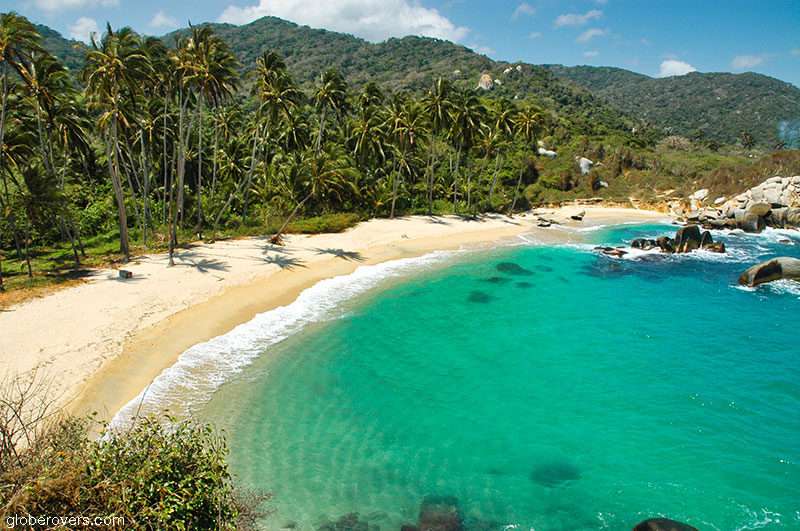
While the area is deemed safe, it’s best to always hike in a small group. Make sure to bring along sunscreen, insect repellent, and plenty of water.
When done with the ruins and the jungle hike, return to the beaches and just relax. Colombia’s Caribbean Coast has been very good to you!
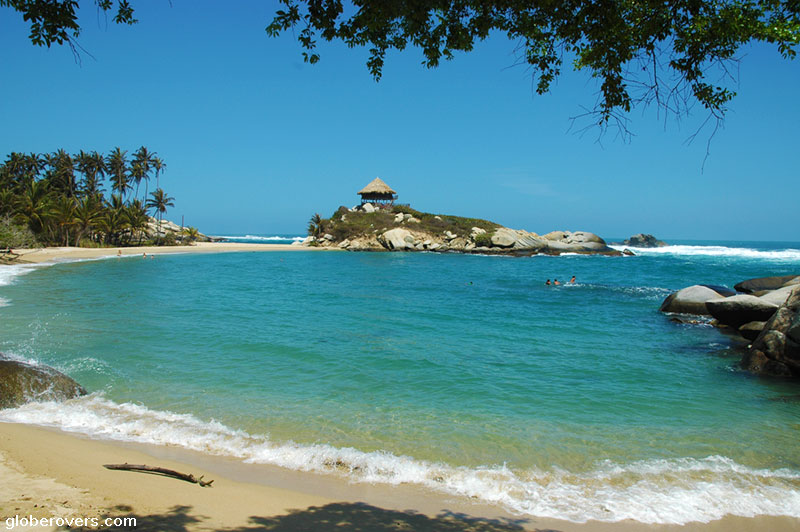

Stay Safe While Travelling in Colombia
Safety precautions in Colombia are much like anywhere else.
Use common sense, be streetwise, and stay away from known danger zones such as the border area with Ecuador and Venezuela due to the risk of kidnapping or being caught in the crossfire of the drug war.
Going off the beaten path might not be the best idea in Colombia, though if this is what makes you tick, first check the safety situation with locals and take along a local guide.
Adding to the uncertainty of the internecine conflict between the government and the guerrilla groups, the wars continue between the police and the drug cartels in places such as Medellin and Cali.
The bright side is that these towns are nowadays safer than they were during the eighties and nineties.
Long-distance travel is best done by plane. Avoid long bus rides, especially overnight trips. If travelling by private car and driver, always keep a low profile.
Enjoy Colombia before it becomes another victim of mass tourism.
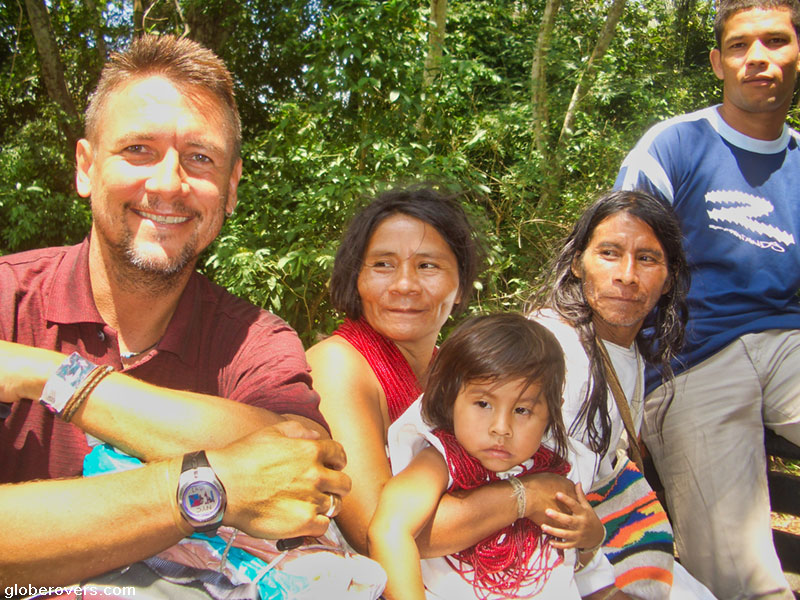
Essential Information
Getting There
Fly into the Colombian capital, Bogota, and from here it is best to fly Viva Air or Avianca Air to Cartagena. The flight takes just 90 minutes and lands at Cartagena’s Rafael Núñez International Airport located 6 minutes drive to the northeast of the old city. Alternatively, take a direct bus (Berlinas del Fonce, Copetran or Expreso Brasilia). It is a 20 to 23-hour journey.
Getting Around
Along the Caribbean coast are several routes by bus and minibus. To reach El Totumo Mud Volcano, take a day trip by minibus from Cartagena. The bus ride to Santa Marta (for Taganga fishing village and nearby beaches) from Cartagena, takes about four hours – a distance of 230 km (143 mi). From Santa Marta to Tayrona National Park, take a minibus to El Zaino.
Photography
Colombia is generally a feast for the eyes, and the north coast is nothing short of beautiful scenery and memorable experiences. The locals are mostly accustomed to tourists taking photos of them, but as always it is best to first ask permission. Don’t forget to bring your camera to the mud volcano, but place it in a thin plastic bag to protect it from the mud.
When to Go
The weather is good all-year-round, but avoid the peak visitor season from mid-December to the end of January and again from mid-June to mid-July when locals flock to the park and beaches. Avoid local holidays such as Easter. Tayrona Park closes for a month around February.
Where to Stay
Cartagena has accommodation for all budgets. Along the coast are many guest houses that cater mostly to the local crowd. During the off season it is easy to find accommodation. At Tayrona Park, try to set up your hammock between two palm trees or stay at the hammock hotel.
Safety
Colombia is safer than it used to be, but it remains a risky destination. However, many travellers to Colombia return safely home without any mishaps. Be extra streetwise everywhere, in particular in Bogota and other big cities. Even Taganga village has reports of street hooligans, so walk cat-foot.
Dining Out
Colombia has delicious traditional foods so try as many of the local dishes as possible. The country is multi-ethnic and food tend to be regionalised. Along the Caribbean coast, seafood is obviously popular, including lobster. Coconut rice is a common dish as are fried plantain patties.
Packing
The weather along the Caribbean coast is good all-year-round. It’s hot and tropical with a rainy season between May and November. The best time is from December to March, since it is the driest, or at least less rainy. Pack a light sweater for cool evenings or when on a boat.
Cost of Travel
Colombia is not dirt-cheap, but also not expensive, depending on how much you want to spend. If on a tight budget, you can get by on $30 to $70 (USD) a day, including everything except airline tickets and long-distance buses. One way flights to Cartagena cost about $120. The bus is $50.
☛ Read more: Blog posts of South America

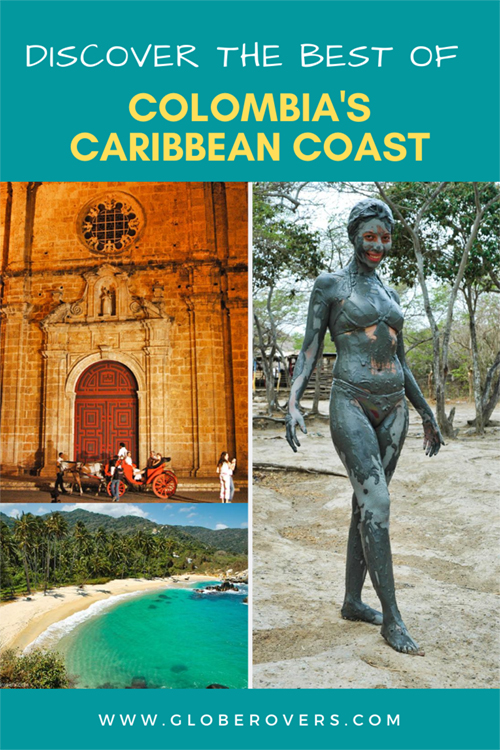

Blog post and photos by Peter who has been travelling almost full-time since 2005 and has been to over 122 countries. He visited several countries, such as Japan, more than 20 times. Peter is Editor-in-Chief and Publisher of GlobeRovers Magazine, an independent travel magazine focused on intrepid destinations.
